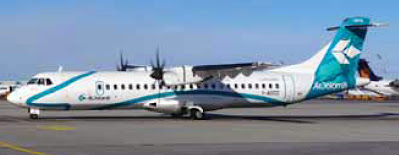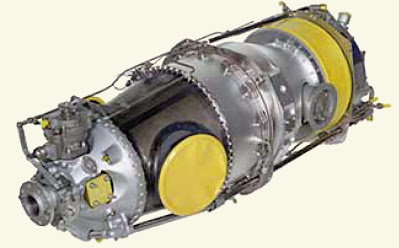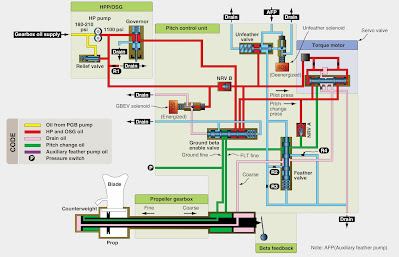Turboprop engines are used for many single, twin, and commuter aircraft. [Figure 1]
RELATED POSTS
Smaller turboprop engines, such as the PT-6, are used on single and twin engine designs; the power ranges from 500 to 2,000 shaft horsepower. [Figure 2]
Large commuter aircraft use turboprop engines, such as the P&W 150 and AE2100 that can deliver up to 5,000 shaft horsepower to power mid-sized to large turboprop aircraft. [Figure 3]
 |
| Figure 3. Pratt & Whitney 150 turboprop engine |
The turboprop propeller is operated by a gas turbine engine through a reduction-gear assembly. It has proved to be an extremely efficient power source. The combination of propeller, reduction-gear assembly, and turbine engine is referred to as a turboprop powerplant.
The turbofan engine produces thrust directly; the turboprop engine produces thrust indirectly because the compressor and turbine assembly furnishes torque to a propeller, producing the major portion of the propulsive force that drives the aircraft. The turboprop fuel control and the propeller governor are connected and operate in coordination with each other.
The turbofan engine produces thrust directly; the turboprop engine produces thrust indirectly because the compressor and turbine assembly furnishes torque to a propeller, producing the major portion of the propulsive force that drives the aircraft. The turboprop fuel control and the propeller governor are connected and operate in coordination with each other.
The power lever directs a signal from the cockpit to the fuel control for a specific amount of power from the engine. The fuel control and the propeller governor together establish the correct combination of rpm, fuel flow, and propeller blade angle to create sufficient propeller thrust to provide the desired power.
The propeller control system is divided into two types of control: one for flight and one for ground operation. For flight, the propeller blade angle and fuel flow for any given power lever setting are governed automatically according to a predetermined schedule. Below the “flight idle” power lever position, the coordinated rpm blade angle schedule becomes incapable of handling the engine efficiently. Here, the ground handling range, referred to as the beta range, is encountered. In the beta range of the throttle quadrant, the propeller blade angle is not governed by the propeller governor, but is controlled by the power lever position. When the power lever is moved below the start position, the propeller pitch is reversed to provide reverse thrust for rapid deceleration of the aircraft after landing.
A characteristic of the turboprop is that changes in power are not related to engine speed, but to turbine inlet temperature. During flight, the propeller maintains a constant engine speed. This speed is known as the 100 percent rated speed of the engine, and it is the design speed at which most power and best overall efficiency can be obtained. Power changes are effected by changing the fuel flow. An increase in fuel flow causes an increase in turbine inlet temperature and a corresponding increase in energy available at the turbine. The turbine absorbs more energy and transmits it to the propeller in the form of torque. The propeller, in order to absorb the increased torque, increases blade angle, thus maintaining constant engine rpm with added thrust.
The propeller control system is divided into two types of control: one for flight and one for ground operation. For flight, the propeller blade angle and fuel flow for any given power lever setting are governed automatically according to a predetermined schedule. Below the “flight idle” power lever position, the coordinated rpm blade angle schedule becomes incapable of handling the engine efficiently. Here, the ground handling range, referred to as the beta range, is encountered. In the beta range of the throttle quadrant, the propeller blade angle is not governed by the propeller governor, but is controlled by the power lever position. When the power lever is moved below the start position, the propeller pitch is reversed to provide reverse thrust for rapid deceleration of the aircraft after landing.
A characteristic of the turboprop is that changes in power are not related to engine speed, but to turbine inlet temperature. During flight, the propeller maintains a constant engine speed. This speed is known as the 100 percent rated speed of the engine, and it is the design speed at which most power and best overall efficiency can be obtained. Power changes are effected by changing the fuel flow. An increase in fuel flow causes an increase in turbine inlet temperature and a corresponding increase in energy available at the turbine. The turbine absorbs more energy and transmits it to the propeller in the form of torque. The propeller, in order to absorb the increased torque, increases blade angle, thus maintaining constant engine rpm with added thrust.
Reduction Gear Assembly
The function of the reduction gear assembly is to reduce the high rpm from the engine to a propeller rpm that can be maintained without exceeding the maximum propeller tip speed (speed of sound). Most reduction gear assemblies use a planetary gear reduction. [Figure 4] Additional power takeoffs are available for propeller governor, oil pump, and other accessories. A propeller brake is often incorporated into the gearbox. The propeller brake is designed to prevent the propeller from windmilling when it is feathered in flight, and to decrease the time for the propeller to come to a complete stop after engine shutdown.
Turbo-Propeller Assembly
The turbo-propeller provides an efficient and flexible means of using the power of the engine at any condition in flight (alpha range). [Figure 5] For ground handling and reversing (beta range), the propeller can be operated to provide either zero or negative thrust. The major subassemblies of the propeller assembly are the barrel, dome, low-pitch stop assembly, overspeed governor, pitch control unit, auxiliary pump, feather and unfeather valves, torque motor, spinner, deice timer, beta feedback assembly, and propeller electronic control. Modern turboprop engines use dual Full Authority Digital Engine Control (FADEC) to control both engine and propeller. The spinner assembly is a cone-shaped configuration that mounts on the propeller and encloses the dome and barrel to reduce drag.
The synchrophasing system is designed to maintain a preset angular relationship between the designated master propeller and the slave propellers. Propeller operation is controlled by a mechanical linkage from the cockpit-mounted power lever and the emergency engine shutdown handle (if the aircraft is provided with one) to the coordinator, which, in turn, is linked to the propeller control input lever. Newer designs use electronic throttle control that is linked to the FADEC controller.
Turbo-propeller control assemblies have a feathering system that feather the propeller when the engine is shut down in flight. The propeller can also be unfeathered during flight, if the engine needs to be started again. Propeller control systems for large turboprop engines differ from smaller engines because they are dual acting, which means that hydraulic pressure is used to increase and decrease propeller blade angle. [Figure 6]





